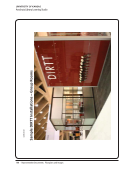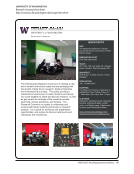SPEC Kit 327: Reconfiguring Service Delivery · 41
Loss of one professional health science librarian in main library, loss of one professional health science librarian in
college of medicine, and loss of one health sciences support staff in main library. Remaining health sciences professional
duties now split between main library services for allied health areas (no specific service point) and college of medicine
Learning Resource Center with dual reporting to libraries and college.
No increase/decrease in FTEs, but existing support staff and graduate academic assistants (library school graduate
students) now report to more than one supervisor in some cases and are cross trained in both sets of disciplines.
One open professional position was moved elsewhere in the library. One of three support positions remained in the ed
school. The other two staff were moved to other areas of the library affected by resignations in those other areas.
One reference librarian works desk hours between traditional business hours with support staff and student assistants.
Student assistants work desk evening and weekend hours.
Originally (five years ago when we launched the transition), this was a very major service initiative at our institution. A
lot of time went into the planning and implementation for librarians and support staff. First we articulated what service
offerings should be provided at the service desks, then competencies were established for the librarians and support
staff to deliver. Some new positions needed to be designed and advertised. A full training program was delivered prior
to the service change and on-going training is an established practice. Some staff did have reporting relationships and
unit structures that changed. However, in this most recent shift (the last four libraries), staff needed training but there
were no re-assignments of units or reporting structures.
Overall this has been a highly successful merger. The Media Center has become a fairly busy “hub,” yet remaining
staff (including student workers) do not appear to be overwhelmed by the amount of work or the variety of collections
serviced.
Reporting relationships changed for most staff across the organization. Most of the former public services librarians
work in one of the new departments: Liaisons to Departments, Labs, or Centers Instruction and Reference Services
Specialized Content &Services User Experience or Information Delivery &Library Access. Many librarians moved offices
and have dual reporting lines to one or more departments.
Reporting relationships did not change.
Reporting structure remained unchanged. Move to open access for media resulted in an impact on collection
development, circulation, and reference staff. The move to open access required review by collection development items
for open or closed media, increased circulation of media impacted circulation and reference. The move, however, went
smoothly and resulted in an increase in circulation of media.
Research Center adopted a single reference librarian and single work-study information student (answering phone and
providing basic directional and catalog help) model staffed by nine bibliographers, two part-time reference librarians,
and two other librarians 70 hours weekly, abandoning outdated staffing (four people) model that traffic no longer
required. The Research Center includes two meeting alcoves: One is used for student-initiated, half-hour appointments
with librarians (thirteen scheduled hours weekly) and the other is staffed eight hours weekly by Writing Center student
tutors.
Science librarians will be brought together from the science annex, math-physics library, and geological sciences library,
and will be based in the new science library. Support staff will manage circulation and stacks and will assist patrons in
locating materials in the science annex. One librarian position was lost to retirement/attrition following the consolidation
of the biology and chemistry libraries in the annex. One staff position has been reassigned elsewhere in the library.
Consolidation of support staff would allow for elimination of a vacant position in the case of a future resignation or
retirement.
Loss of one professional health science librarian in main library, loss of one professional health science librarian in
college of medicine, and loss of one health sciences support staff in main library. Remaining health sciences professional
duties now split between main library services for allied health areas (no specific service point) and college of medicine
Learning Resource Center with dual reporting to libraries and college.
No increase/decrease in FTEs, but existing support staff and graduate academic assistants (library school graduate
students) now report to more than one supervisor in some cases and are cross trained in both sets of disciplines.
One open professional position was moved elsewhere in the library. One of three support positions remained in the ed
school. The other two staff were moved to other areas of the library affected by resignations in those other areas.
One reference librarian works desk hours between traditional business hours with support staff and student assistants.
Student assistants work desk evening and weekend hours.
Originally (five years ago when we launched the transition), this was a very major service initiative at our institution. A
lot of time went into the planning and implementation for librarians and support staff. First we articulated what service
offerings should be provided at the service desks, then competencies were established for the librarians and support
staff to deliver. Some new positions needed to be designed and advertised. A full training program was delivered prior
to the service change and on-going training is an established practice. Some staff did have reporting relationships and
unit structures that changed. However, in this most recent shift (the last four libraries), staff needed training but there
were no re-assignments of units or reporting structures.
Overall this has been a highly successful merger. The Media Center has become a fairly busy “hub,” yet remaining
staff (including student workers) do not appear to be overwhelmed by the amount of work or the variety of collections
serviced.
Reporting relationships changed for most staff across the organization. Most of the former public services librarians
work in one of the new departments: Liaisons to Departments, Labs, or Centers Instruction and Reference Services
Specialized Content &Services User Experience or Information Delivery &Library Access. Many librarians moved offices
and have dual reporting lines to one or more departments.
Reporting relationships did not change.
Reporting structure remained unchanged. Move to open access for media resulted in an impact on collection
development, circulation, and reference staff. The move to open access required review by collection development items
for open or closed media, increased circulation of media impacted circulation and reference. The move, however, went
smoothly and resulted in an increase in circulation of media.
Research Center adopted a single reference librarian and single work-study information student (answering phone and
providing basic directional and catalog help) model staffed by nine bibliographers, two part-time reference librarians,
and two other librarians 70 hours weekly, abandoning outdated staffing (four people) model that traffic no longer
required. The Research Center includes two meeting alcoves: One is used for student-initiated, half-hour appointments
with librarians (thirteen scheduled hours weekly) and the other is staffed eight hours weekly by Writing Center student
tutors.
Science librarians will be brought together from the science annex, math-physics library, and geological sciences library,
and will be based in the new science library. Support staff will manage circulation and stacks and will assist patrons in
locating materials in the science annex. One librarian position was lost to retirement/attrition following the consolidation
of the biology and chemistry libraries in the annex. One staff position has been reassigned elsewhere in the library.
Consolidation of support staff would allow for elimination of a vacant position in the case of a future resignation or
retirement.






















































































































































































































